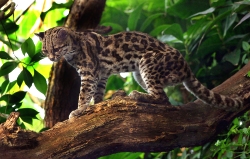Margay cats - tree-hugging mimics of South America

Have you ever had your cat stuck in a tree? Well, meet Leopardus wiedii; a species of cat which is almost entirely arboreal. These cats spend most of their lives in trees and hardly ever come down to the ground. Leopardus wiedii is generally known as the Margay cat - as far as it is known at all. You wonít find this cat hanging around the local dustbins, because the Margay cat is a denizen of the Central/South American rain forests. Mexico is as far north as these cats range and northern Argentina is their southernmost limit. In appearance, the Margay cat is very similar to its larger cousin the ocelot, but while ocelots may frequently go up trees, Margay cats almost never come down.
Like the ocelot, the Margay catís coat is brownish yellow with black spots, stripes and blotches arranged in longitudinal rows. This almost perfectly camouflages the cat amid the leaves and branches of its habitat. The centre of each spot is slightly paler, but still darker than the base colour of the fur. The belly, chest, throat, chin, and insides of the legs are a snowy white. The Margay catís tail is very long (almost 70% of the length of the body) and it is used for stability when the cat jumps from tree to tree. An average Margay cat weighs 3 - 4 kg (9-11 lbs), though larger cats of up to 9 kg (20 lbs) have been reported.
The Margay is a true tree cat. In some areas, Margay cats hunt, sleep, and even give birth in trees. Their soft, large paws have flexible toes which gives them a monkey-like grip and are well suited for walking on the tree branches. When in need they can jump over eight feet (2.5 meters) straight up. When moving from tree to tree they have been seen to jump horizontally almost nine meters. They are the only cats which can hang down from branches using their back feet. Those feet have a unique bone structure in the ankles which allows them to rotate 180 degrees. Margay cats have superb reflexes. Even during a fall they can grab hold of a branch with one hind paw and climb up again. When they descend from a tree, they walk down the trunk head-first.
You can see the exceptional agility of the Margay cat in this video:
Like most wild felines, Margay cats are solitary, with the adults commonly meeting only to mate. The gestation period for a pregnant female is about 80 days, and results in the birth of only a single kitten (or, on very rare occasions, two), usually between March and June. The kittens weigh 85 to 170 grams at birth. This is relatively large for a small cat, and is probably related to the long gestation period.
Margays are rare even within their natural environment. Each occupies a relatively large home range of 11 to 16 square kilometres. Like most cats, Margays are nocturnal and do much of their hunting at dusk and dawn. Their prey is small, tree dwelling rodents, opossums, squirrels, sloths, monkeys, porcupines, birds, insects, and occasionally fruit.
When hunting Margay cats have an amazing trick - they mimick the sounds of their prey. A fascinating example of such vocal mimicry has been reported in Neotropical Primates journal last year (see reference below) where researchers from the Wildlife Conservation Society (WCS) and UFAM (Federal University of Amazonas) documented a Margay imitating the call of its intended victim: a small, squirrel-sized monkey known as a pied tamarin.
The researchers first noticed a group of eight pied tamarins which were feeding in a ficus tree. Then they observed a Margay cat making calls similar to those made by tamarin babies. This attracted the attention of a tamarin "sentinel", which climbed down from the tree to investigate the sounds coming from a tangle of vines called lianas. While the sentinel monkey started vocalizing to warn the rest of the group of the strange calls, the monkeys were clearly confounded by these familiar vocalizations, choosing to investigate rather than flee. Four other tamarins climbed down to investigate the nature of the calls. At that moment, a margay emerged from the foliage walking down the trunk of a tree in a squirrel-like fashion, jumping down and then moving towards the monkeys. Realizing the mistake, the sentinel screamed an alarm and sent the other tamarins fleeing.
While this specific instance of vocal mimicry was unsuccessful in catching any prey, researchers were amazed at the ingenuity of the Margay catís hunting strategy and believe that this was not an isolated incident.
Reference:
Fabiano de Oliveira Calleia, Fabio Rohe, Marcelo Gordo. Hunting Strategy of the Margay (leoparduswiedii) to Attract the Wild Pied Tamarin (saguinus Bicolor). Neotropical Primates 16(1), June 2009 pp32-34.

